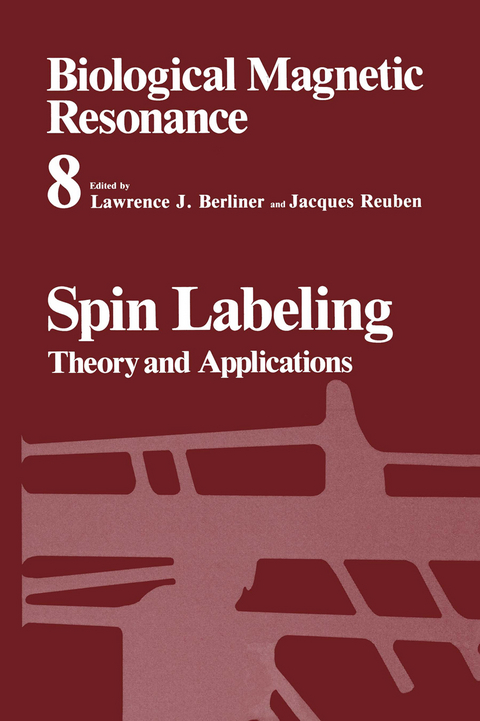
Spin Labeling
Springer-Verlag New York Inc.
978-1-4612-8060-6 (ISBN)
Dr. Lawrence J. Berliner is currently Professor and Chair of the Department of Chemistry and Biochemistry at the University of Denver after retiring from Ohio State University, where he spent a 32-year career in the area of biological magnetic resonance (EPR and NMR). He is the Series Editor for Biological Magnetic Resonance, which he launched in 1979.
1 Calculating Slow Motional Magnetic Resonance Spectra: A User’s Guide.- 1. Introduction.- 2. General Theoretical Considerations.- 2.1. Terms Included in the Liouville and Diffusion Superoperators.- 2.2. Definitions of Coordinate Systems.- 2.3. Basis Vectors and Scalar Product in Operator Space.- 2.4. Construction of the Spin Hamiltonian.- 2.5. Matrix Elements of the Liouville Superoperator.- 2.6. Construction and Matrix Elements of the Diffusion Super-operator.- 2.7. Components of the Starting Vector.- 2.8. The High-Field Approximation.- 3. Magnetic Resonance Line Shapes and the Complex Symmetric Lanczos Algorithm.- 3.1. The Real Symmetric Lanczos Algorithm.- 3.2. The Complex Symmetric Lanczos Algorithm.- 3.3. The Real Symmetric Conjugate Gradients Algorithm.- 3.4. The Complex Symmetric Conjugate Gradients Algorithm.- 3.5. The Continued-Fraction Representation of the Spectral Function.- 3.6. Convergence of the Sequence of Approximate Spectral Functions.- 4. Computational Considerations.- 4.1. Naming Conventions for Files.- 4.2. Array Dimensions and Common Blocks.- 4.3. The Parameter Input Program: LBLL.- 4.4. Spectral Calculations: EPRLL and EPRCGL.- 4.5. Calculation of the Spectral Function: TDLL.- 4.6. “Field Sweep” Conjugate-Gradients Calculations: EPRBL and TNLL.- 4.7. Auxiliary Programs: D200, STVT, MATLST, and VECLST.- 4.8. Porting Programs to Other Machines.- 5. Example Calculations.- 5.1. Model Calculations and General Strategy.- 5.2. Examples from the Literature.- Appendix: Parameters for Example Calculations.- References.- 2 Inhomogeneously Broadened Spin-Label Spectra.- 1. Introduction.- 2. Experimental Determination of Hyperfine Coupling Constants.- 2.1. NMR and ENDOR.- 2.2. ESR Simulation.- 2.3. Solvent Dependence of Hyperfine Coupling Constants.- 3.Gaussian Contributions to Spin-Label Line Shapes.- Example 1.- 4. The Voight Approximation and a One-Parameter Description of Line Shapes.- Example 2.- 5. Line-Shape Comparisons.- 5.1. Unresolved Hyperfine Multiplets.- 5.2. A Universal Nitroxide.- 5.3. Gaussian-Lorentzian Sum Approximations.- 6. Correcting the Linewidth of an Inhomogeneously Broadened Line.- 6.1. Known Hyperfine Coupling Constants.- Example 3. Solvent Dependence of ?HppG.- Example 4. Dependence of ?HppGon Spin-Label Alignment in an Ordered Fluid.- 6.2. Unknown Hyperfine Coupling Constants.- Example 5.- 6.3. Additional Broadening Method.- 7. The Relationship of Linewidth Ratios to Measured Line-Height Ratios.- 7.1. Rotational Correlation Times.- Example 6.- 7.2. Linewidth Ratios Over a Broader Range.- Example 7. Measuring Oxygen Concentrations Using Unresolved Spin-Label Spectra.- 8. Accurate Estimate of Relative Doubly-Integrated Spectral Intensities.- Example 8. A Hypothetical Spin-Label Partitioning Experiment.- 9. Determining Spin-Exchange Frequencies of Spin Labels in Liquids of Low Viscosity.- 10. Deuterated Spin Labels.- 10.1. Gaussian Linewidth of Deuterated Spin Labels.- 10.2. Proton Contamination of a Deuterated Spin Label.- Example 9.- Example 10.- 11. Conclusions.- References.- 3 Saturation Transfer Spectroscopy of Spin Labels: Techniques and Interpretation of Spectra.- 1. Introduction.- 2. Basic Principles of Saturation Transfer ESR.- 2.1. The Spin Hamiltonian.- 2.2. ESR Spectra of Immobilized Spin Labels.- 2.3. The Bloch Equations.- 2.4. Qualitative Explanation of ST-ESR.- 2.5. Spectral Displays of ST-ESR.- 2.6. Analysis of ST-ESR Spectra.- 3. Measurements of Saturation Transfer ESR Spectra.- 3.1. The Resonant Cavity.- 3.2. Effect of Sample on Cavity Properties.- 3.3. Phase-SensitiveDetection.- 3.4. Calibration Procedures.- 3.5. Standard Conditions for ST-ESR Spectroscopy.- 4. Analysis of Saturation Transfer ESR Spectra.- 4.1. Isotropic Motion.- 4.2. Anisotropic Motion.- 5. Future Developments.- References.- 4 Nitrogen-15 and Deuterium Substituted Spin Labels for Studies of Very Slow Rotational Motion.- 1. Introduction.- 2. Overview of Rotational Diffusion Models.- 2.1. Definition of Rotational Correlation Times.- 2.2. Isotropic Rotational Diffusion.- 2.3. Anisotropic Rotational Diffusion in an Isotropic Medium.- 2.4. Uniaxial Rotational Diffusion in an Anisotropic Medium.- 3. Sensitivity of cw-ST-EPR Signals to Rotational Motion.- 3.1. Choice of Signal.- 3.2. Sensitivity to Motion.- 3.3. The Case of Isotropic Motion and Anisotropic Magnetic Tensors.- 3.4. Effects of Anisotropic Motion and Anisotropic Tensors.- 3.5. Geometric Considerations for Analyzing Anisotropic Motion.- 4. Analysis of cw-ST-EPR Data.- 4.1. Isotropic Model Systems.- 4.2. Anisotropic Model Systems.- 4.3. Anisotropic Motional Modeling by Computer Simulations.- 4.4. Overview of Theory for Computation of ST-EPR Spectra.- 5. Studies of Isotropic Motion with Nitrogen-15 Spin Labels.- 5.1. V1EPR Signals as a Function of ?r.- 5.2. Dependence of the V?2Signal on ?r.- 6. Effects of Anisotropic Rotational Diffusion on V?2Spectra.- 6.1. Sensitivity of V?2to Uniaxial Rotation.- 6.2. Effects of Labeling Geometry.- 6.3. Sensitivity of V’2to Anisotropic Rotational Diffusion of Axially Symmetric Ellipsoids in an Isotropic Medium.- 6.4. Relationship between Effective Correlation Times and Anisotropic Motion.- 7. Optimization of Sensitivity of V’2to Motion.- 7.1. Altering Sensitivity to Motion by Selection of v0.- 7.2. Altering Sensitivity to Motion by Selection of vm.- 8. Analysisof Overlapping Motional Species.- 8.1. One Fast and One Slow Motional Component.- 8.2. Two or More Slow Motional Components.- 9. Computer Modeling of Nitrogen-14 V’2Signals.- 9.1. Isotropic Motion Simulations.- 9.2. Anisotropic Motion Simulations.- 9.3. Signal-to-Noise Ratio and Motional Sensitivity of Nitrogen-15 versus Nitrogen-14 Spin Labels.- 10. Saturation Recovery EPR Studies with Nitrogen-15 Spin Labels.- 10.1. Overview of the Experiment.- 10.2. Spectrometer Variables.- 10.3. Strategies for Extraction of Motional Information.- 10.4. Theory of Saturation Recovery.- 10.5. Pseudosecular Terms.- 10.6. Isotropic Brownian Motion—Secular Terms Only.- 10.7. Results of Calculations of SR Curves for Isotropic Motion.- 10.8. Results of Calculations of SR Curves for Nonaxial Tensors.- 10.9. Effects of Pseudosecular Terms.- 10.10. Pseudosecular Terms using Nitrogen-14.- 10.11. Population Analysis: An Estimate of Amplitudes.- 11. Conclusions.- References.- 5 Experimental Methods in Spin-Label Spectral Analysis.- 1. Introduction.- 2. Inhomogeneous Broadening.- 3. Fast Rotational Motion.- 4. Slow Rotational Motion.- 5. Anisotropic Rotation: Lipids/Membranes.- 6. Spin-Spin Interactions and Lateral Diffusion.- 6.1. Spin-Spin Exchange.- 6.2. Translational Diffusion and Bimolecular Collision Rate.- 6.3. Dipolar Spin-Spin Broadening.- 6.4. Separation of Exchange and Dipole-Dipole Interactions.- 7. Lipid-Protein Interactions.- 7.1. Spectral Subtraction/Addition.- 7.2. Measurements at 35 GHz.- 7.3. Analysis of Lipid-Protein Association.- 7.4. Two-Site Exchange Simulations.- 8. Saturation Transfer ESR.- 8.1. Power and Modulation Calibration and the Effects of Sample Shape, Size, and Dielectric Absorption.- 8.2. Anisotropic Rotation.- 8.3. Integral Method: Multicomponent Spectra.-8.4. Dispersion Spectra: Difference Spectroscopy.- References.- 6 Electron-Electron Double Resonance.- 1. Introduction.- 1.1. Definitions and Background.- 1.2. Historical Overview.- 2. Rate Equations.- 3. Spin-Label Relaximetry.- 4. Apparatus.- 5. Applications.- 5.1. Lateral Diffusion in Membranes.- 5.2. Studies Utilizing 14N: 15N Spin-Label Pairs.- 5.3. ELDOR in Cells.- 5.4. Comparison with Spin-Exchange Line Broadening.- 5.5. Further Application of 14N: 15N Methodology.- 6. Future Opportunities.- References.- 7 Resolved Electron-Electron Spin-Spin Splittings in EPR Spectra.- 1. The Scope of Electron Spin-Spin Interactions.- 2. The Nature of Electron Spin-Spin Interactions.- 2.1. Dipolar Interaction.- 2.2. Exchange Interaction.- 2.3. Hamiltonian for Spin-Spin Interaction.- 2.4. Computational Approaches.- 3. Analogies between Nuclear-Nuclear, Electron-Nuclear, and Electron-Electron Spin-Spin Interactions and Long-Range Electron Transfer.- 4. Spin-1/2-Spin-1/2 Interaction.- 4.1. Spin-Spin Splitting.- 4.2. Half-Field Transitions.- 4.3. Geometrical Information.- 5. Spin 1-Spin 1/2.- 6. Spin 3/2-Spin 1/2.- 7. Spin 5/2-Spin 1/2.- 7.1. Mn(II) Interacting with S= 1/2.- 7.2. High-Spin Fe(III) Interacting with S= 1/2.- 8. Spin 7/2-Spin 1/2.- 9. Chemical Properties Revealed via Spin-Spin Interactions.- 9.1. Kinetics of Ligand Exchange for Cu(II) i..- 9.2. Coordination Equilibria.- 9.3. Weak Orbital Overlaps.- 10. Spin-Spin Interactions in Biological Systems.- 10.1. Cobalt(II) - Radical Interaction.- 10.2. Mo(V) Interaction with Fe/S Cluster.- 10.3. Iron-Nitroxyl Interaction.- 10.4. Nitroxyl-Nitroxyl Interaction.- 11. Exchange Interaction through Multiatom Linkages.- 12. Quantitative EPR Measurements.- 13. Summary and Prognosis.- References.- 8 Spin-Label Oximetry.- 1. Introduction.- 2. Physics.- 2.1. Bimolecular Collisions.- 2.2. Magnetic Interactions.- 2.3. The Absolute T1Method.- 2.4. The Absolute T2Method.- 3. Experimental Methods.- 3.1. TPX Gas-Exchange Sample Cell.- 3.2. T1Sensitive Methods.- 3.3. T2(Linewidth-Sensitive) Methods.- 4. Applications.- 5. Future Opportunities.- References.- 9 Chemistry of Spin-Labeled Amino Acids and Peptides: Some New Mono- and Bifunctionalized Nitroxide Free Radicals.- 1. Introduction.- 2. Spin Labeling of Amino Acids and Peptides.- 2.1. Reagents for Labeling at the Amino Terminal.- 2.2. C-Terminal Spin-Labeled Amino Acids and Peptides.- 2.3. Amino Acids and Peptides Labeled in the Side Chain.- 3. Nitroxide Amino Acids.- 3.1. Imidazolinyl Nitroxide Amino Acids.- 3.2. Pyrrolidine Nitroxide Amino Acids.- 3.3. Pyrrolinyl Nitroxide Amino Acids.- 3.4. Piperidinyl Nitroxide Amino Acids.- 4. New Mono- and Bifunctionalized Spin Labels.- 4.1. Reactions with 3-Functionalized-3-Pyrroline-l-Oxyl Derivatives.- 4.2. Cross-Linking Spin-Label Reagents.- 4.3. Spin-Labeled Pyrrolidine-1-Oxyl Fatty Acids.- 5. Experimental Procedures for Preparation of Some Pyrroline and Pyrrolidine Nitroxide Spin Labels.- References.- 10 Nitroxide Radical Adducts in Biology: Chemistry, Applications, and Pitfalls.- 1. Introduction.- 2. Halogenated Compounds.- 2.1. Carbon Tetrachloride.- 2.2. Halothane.- 2.3. Others.- 3. Lipid Peroxidation.- 3.1. Linoleic Acid.- 3.2. Methyl Linoleate.- 3.3. Arachidonic Acid.- 3.4. Lipid Peroxyl and Alkoxy Radicals.- 4. Hemoprotein-Organic Hydroperoxides.- 5. Sulfur-Centered Radicals.- 5.1. Sulfur Dioxide, Bisulfite, Sulfite, and Sulfate.- 5.2. Thiols.- 6. Pyridinyl Radicals.- 7. Hydrazines.- 8. Oxygen-Centered Radicals.- 9. Aldehydes.- 9.1. Glyceraldehyde and Other Monosaccharides.- 9.2. Malonaldehyde and Acetylacetone.- 10. Lignin Model Dimers.- 11. 3-Methylindole.- 12. Indole Acetic Acid.- 13. Ethanol.- 14. Tryptophan.- 15. Nitrobenzyl Chlorides.- 16. Azide and Cyanide.- 17. Styrene.- 18. Spin Traps as Enzyme Inhibitors.- 19. Spin Traps as Enzyme Substrates.- 20. In VivoSpin Trapping and Spin Trapping in Cells.- 20.1. Spin Trapping in Cells.- 20.2. Site-Directed Spin Traps.- 20.3. In VivoSpin Trapping.- 21. Spin Adduct Identification.- 21.1. Isotope Methods.- 21.2. Isolation and Identification by HPLC, GC, and MS.- 22. Spin Adduct Imposters.- 23. Summary.- References.- 11 Advantages of 15N and Deuterium Spin Probes for Biomedical Electron Paramagnetic Resonance Investigations.- 1. Introduction.- 2. Maleimide Spin Label (DMSL or 15N,DMSL): A Covalent Ligand for Sulfhydryl Groups of Proteins.- 2.1. Advantages of Deuterated Maleimide Spin Label (DMSL) for Studies of Proteins.- 2.2. Advantages of Doubly Substituted 15N,Deuterated Maleimide Spin Label (15N,DMSL).- 2.3. Advantages of 15N,Deuterated Maleimide Spin Label (15N,DMSL) for Studies of Soluble and Membrane-Bound Enzymes.- 2.4. Future Applications.- 3. Coenzyme Spin Labels: Studies on Coenzyme Binding to Enzymes and Catalytic Mechanisms.- 3.1. Comparison of Spin-Labeled Maleimide Inhibitors (DMSL and 15N,DMSL) and Coenzyme Analogs (SL-NAD+) for EPR.- Studies of Enzymes.- 3.2. The Evaluation of Binding of Isotopically Substituted N6-SL- NAD+or C8-SL-NAD+Using Lactic Dehydrogenase.- 3.3. Glyceraldehyde-3-phosphate Dehydrogenase (GAPDH) and SL-NAD+Binding with Unusual Electron-Electron Dipolar Interactions (Splitting of Peaks).- 3.4. Interactions of N6-(D17M)SL-NAD+with GAPDH Bound to Band-3 Protein of Erythrocyte Membranes.- 3.5. Binding of Deuterated and 15N,Deuterated-SL-NADH Analogs to ß-Hydroxybutyrate Dehydrogenase(BDH).- 3.6. Binding of Spin-Labeled Adenine Nucleotides to Dehydrogenases and F1ATPase.- 3.7. Future Applications.- 4. Advantages of 15N, and 15N,Deuterated Stearic Acid and Cholestane Spin Labels for Evaluation of Motion of Lipids in Membranes.- 4.1. Improved Spectral Sensitivity of Rapidly Tumbling 15N and 15N,Deuterium Substituted Stearic Acid and Cholestane Analogs.- 4.2. Advantages of 15N and 15N,Deuterated Stearic Acid Spin Labels for Studies on Binding to Proteins.- 4.3. Improved Spectral Analysis of Lipid Motion in Erythrocyte (RBC) Membranes with 15N-5-NS and (15N,D12)-5-NS.- 4.4. Investigation of Erythrocyte Abnormalities Using 15N-5-NS.- 4.5. Studies of Collision Frequency and Vertical Fluctuations of 14N and 15N Spin-Labeled Pairs of Fatty Acids in Membranes Using ELDOR Spectroscopy.- 4.6. Future Applications.- References.- 12 Magnetic Resonance Study of the Combining Site Structure of a Monoclonal Anti-Spin-Label Antibody.- 1. Introduction.- 2. Amino Acid Composition of the Antibody Combining Site.- 3. Distance Determination.- 4. Contributions of Heavy and Light Chains to the Combining Site.- 5. Determination of Short Distances.- 6. Conclusion.- References.- Appendix Approaches to the Chemical Synthesis of l5N and Deuterium Substituted Spin Labels.- 1. Introduction.- 2. Synthesis of Deuterated and 15N,Deuterated Maleimide Spin Labels (DMSL and 15N-DMSL).- 3. Synthesis of Deuterated and 15N,Deuterated Adenine Nucleotide Derivatives.- 3.1. Synthesis of N6-(D17)SL-AMP (10a) or N6-(15N,D17)SL-AMP (10b).- 3.2. Synthesis of C8-(D17)SL-AMP (12a) or C8(15N,D17)SL-AMP (12b).- 3.3. Synthesis of N6-SL-ATP (14).- 3.4. Synthesis of C8-(15N,D17)SL-ATP.- 3.5. Synthesis of N6- or C8-SL-Analogs of AMPPCP or AMPPNP.- 3.6. Synthesis of a Mixture of 2?- and3?-(15N,D13)SL-ATP (17).- 3.7. Synthesis of N6-SL-ADP and C8-SL-ADP.- 3.8. Synthesis of N6-(D17)SL-NAD+ (18a) and N6-(15N,D17)SL- NAD+(18b).- 3.9. Synthesis of C8-(D17)SL-NAD+and C8-(15N,D17)SL-NAD+.- 4. Synthesis of 15N and 15N,Deuterated Stearic Acid Spin Labels.- 4.1. Synthesis of 15N-5-Doxylstearic Acid Spin Label (26).- 4.2. Synthesis of 15N-12-Doxylstearic Acid-d41(27).- 5. Conclusions.- References.- of Previous Volumes.
| Reihe/Serie | Biological Magnetic Resonance ; 8 |
|---|---|
| Zusatzinfo | 670 p. |
| Verlagsort | New York, NY |
| Sprache | englisch |
| Maße | 152 x 229 mm |
| Themenwelt | Sachbuch/Ratgeber ► Natur / Technik ► Garten |
| Naturwissenschaften ► Biologie ► Biochemie | |
| Naturwissenschaften ► Chemie ► Analytische Chemie | |
| Naturwissenschaften ► Physik / Astronomie ► Angewandte Physik | |
| Technik ► Umwelttechnik / Biotechnologie | |
| ISBN-10 | 1-4612-8060-5 / 1461280605 |
| ISBN-13 | 978-1-4612-8060-6 / 9781461280606 |
| Zustand | Neuware |
| Haben Sie eine Frage zum Produkt? |
aus dem Bereich


